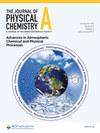Cr(III)和Fe(III)单离子磁铁与Fe(II)自旋交叉配合物之间超分子组装的磁性和热力学计算
IF 2.7
2区 化学
Q3 CHEMISTRY, PHYSICAL
The Journal of Physical Chemistry A
Pub Date : 2024-12-06
DOI:10.1021/acs.jpca.4c0672310.1021/acs.jpca.4c06723
引用次数: 0
摘要
两种超分子配合物的实验结果表明,在一对FeII自旋交叉基团之间嵌入了CrIII或FeIII d轨道单离子磁体中心,这两种配合物很有可能用于量子信息技术。我们报告了它们的结构和电子特性的详细计算结果,并使用所得数据参数化自旋哈密顿量,以便与实验结果进行比较及其解释。与[Fe(ox)3]@[Fe2L3]+的退相干实验结果一致,发现[Cr(ox)3]@[Fe2L3]+体系为易平面型,而[Cr(ox)3]@[Fe2L3]+体系为易轴型。本文章由计算机程序翻译,如有差异,请以英文原文为准。

Magnetic and Thermodynamic Computations for Supramolecular Assemblies between a Cr(III) and Fe(III) Single-Ion Magnet and an Fe(II) Spin-Crossover Complex
Experimental results on two supramolecular complexes in which a CrIII or FeIII d-orbital single-ion magnet center is embedded between a pair of FeII spin-crossover moieties make those two complexes interesting as possible candidates for use in quantum information technologies. We report detailed computational results for their structure and electronic properties and use the resulting data to parametrize a spin Hamiltonian that facilitates comparison with experimental results and their interpretation. Consistent with experimental results on decoherence in [Fe(ox)3]@[Fe2L3]+, we find it to be easy-plane type while the [Cr(ox)3]@[Fe2L3]+ system is easy-axis type.
求助全文
通过发布文献求助,成功后即可免费获取论文全文。
去求助
来源期刊

The Journal of Physical Chemistry A
化学-物理:原子、分子和化学物理
CiteScore
5.20
自引率
10.30%
发文量
922
审稿时长
1.3 months
期刊介绍:
The Journal of Physical Chemistry A is devoted to reporting new and original experimental and theoretical basic research of interest to physical chemists, biophysical chemists, and chemical physicists.
 求助内容:
求助内容: 应助结果提醒方式:
应助结果提醒方式:


